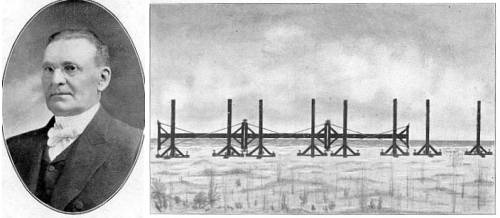“The uglier a man’s legs are, the better he plays golf. It’s almost a law.” — H.G. Wells
Rejected

In 1989, Jules Verne’s great-grandson opened a disused family safe and found a forgotten manuscript. Composed in 1863, Paris in the Twentieth Century imagines the remote future of August 1960 — a world illuminated by electric lights in which people drive horseless carriages powered by internal combustion and ride in automatic, driverless trains.
In Verne’s vision, the citizens of Paris use copiers, calculators, and fax machines; inhabit skyscrapers equipped with elevators and television; and execute their criminals in electric chairs. Twenty-six years before the Eiffel Tower was erected, Verne described “an electric lighthouse, no longer much used, [that] rose into the sky to a height of 152 meters. This was the highest monument in the world, and its lights could be seen, forty leagues away, from the towers of Rouen Cathedral.”
Verne’s publisher had returned the manuscript because he found it too dark — in addition to the city’s technological wonders, it describes overcrowding, pollution, the dissolution of social institutions, and “machines advantageously replacing human hands.”
“No one today,” he had written, “will believe your prophecy.”
In a Word
hystricine
adj. pertaining to porcupines
Reading Matter
In a certain library, no two books contain the same number of words, and the total number of books is greater than number of words in the largest book.
How many words does one of the books contain, and what is it about?
Polar Express

This ought to work — in 1966, D.R. Petrik proposed replacing the wheels of trains with blocks of ice.
More precisely, the wheels (101) would be bracketed by ice blocks (102), which are pressed downward against the heated track and assume the weight of the train. As the blocks melt they can be replaced with fresh ones from refrigerated compartments in the car (103) “without stopping the train or engaging the wheels.”
If it’s not pulled by a locomotive, the whole business can be propelled by jet or rocket thrust, or perhaps propellers. “Of course the wheels could be eliminated altogether in suitable cases, although their retention may be persuaded by the desire to provide an emergency or reserve means of support.” Happy landings.
Trivium
Marlon Brando and Robert De Niro are the only actors to win Oscars playing the same character. Brando won Best Actor for playing Vito Corleone in The Godfather in 1972, and De Niro won Best Supporting Actor for the same role in The Godfather Part II in 1974.
See Too Much Talent.
Little America
An ancient graveyard of vast proportions has been found in Coffee county [Tenn.]. It is similar to those found in White county and other places in Middle Tennessee, but is vastly more extensive, and shows that the race of pigmies who once inhabited this country were very numerous. The same peculiarities of position observed in the White county graves are found in these. The writer of the letter says:– ‘Some considerable excitement and curiosity took place a few days since, near Hillsboro, Coffee county, on James Brown’s farm. A man was ploughing in a field which had been cultivated many years, and ploughed up a man’s skull and other bones. After making further examination they found that there were about six acres in the graveyard. They were buried in a sitting or standing position. The bones show that they were a dwarf tribe of people, about three feet high. It is estimated that there were about 75,000 to 100,000 buried there. This shows that this country was inhabited hundreds of years ago.’
— Woodbury [Tenn.] Press, quoted in The Journal of the Anthropological Institute, Feb. 8, 1876
A short distance below Coshocton [Ohio], on one of those elevated, gravelly alluvions, so common on the rivers of the West, has been recently discovered a very singular ancient burying ground. From some remains of wood, still apparent in the earth around the bones, the bodies seem all to have been deposited in coffins; and what is still more curious, is the fact that the bodies buried here were generally not more than from three to four and a half feet in length. They are very numerous, and must have been tenants of a considerable city, or their numbers could not have been so great. A large number of graves have been opened, the inmates of which are all of this pigmy race. No metallic articles or utensils have yet been found, to throw light on the period or the nation to which they belonged. Similar burying grounds have been found in Tennessee, and near St. Louis in Missouri.
— The American Journal of Science and Arts, January 1837
Inner Vision

In 1897, Cyrus Teed proved that we inhabit a hollow earth. He did this by building a “Rectilineator,” essentially a giant straightedge that could extend a perfectly straight line across a great distance. On a convex earth this line should rise gradually in altitude as the earth’s surface falls away from it. But in his trials in Florida, Teed found that the line ran into the earth after 4 1/8 miles, proving that the surface is concave, in accord with his “Koreshan cosmogony.”
The extension of the arc of curvature which we have measured and have demonstrated to be concave, forms a circumference of about 25,000 miles; which conclusion, taken in connection with all the astronomical, geographical, and geodetic facts obtained by centuries of observation and survey, demonstrates that the surface of the earth upon which we live is the inner surface of a great cell about 8,000 miles in diameter.
“No one has ever seriously attempted either to debunk or to repeat the Rectilineator experiment,” writes John Michell in Eccentric Lives and Peculiar Notions, “but it is natural for those who can not bring themselves to accept its results to wonder how they were obtained. The Rectilineator apparatus, though cumbersome, was scientifically sound, and so was the principle behind its use, and one can hardly suppose that the Koreshan surveyors, who lived by the doctrines of their leader, were engaged in an elaborate conspiracy of deception. Perhaps the answer lies in the malleable, obliging nature of the universe, which reflects every image projected upon it and gives every experiment a tendency to gratify the experimenter.”
A Higher Star
At a dinner, Oliver Herford found himself sitting next to a very serious young woman.
“Tell me, Mr. Herford,” she said. “Have you no ambition beyond making people laugh?”
“Yes, I have,” he replied. “And someday I hope to gratify it.”
“Please tell me,” she said eagerly. “What is it?”
He said, “I want to throw an egg into an electric fan.”
Nothing in Common

SOUTH DAKOTA shares no letters with its capital, PIERRE. It’s the only such state.
